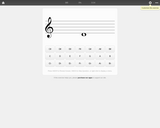
This interactive online tool will quiz your students on naming/identifying notes. It is customizable so you can use treble, bass, grand, alto, or tenor clefs. Great for practice and reinforcing knowledge.

This interactive online tool will quiz your students on naming/identifying notes. It is customizable so you can use treble, bass, grand, alto, or tenor clefs. Great for practice and reinforcing knowledge.

Printable student investigation guide for OpenSciEd unit 8.1: Contact Forces for lesson 5

Resource has discussion questions, extension activities and information about the real Ivan. Some of the extension activities include links to other sites with informatin pertaining to The One and Only Ivan.
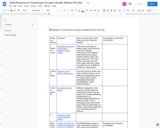
Running List of Resources for Selecting Culturally-Relevant Texts
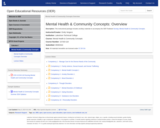
This instructional package includes ancillary materials to accompany the OER Textbook Nursing: Mental Health & Community Concepts (https://wtcs.pressbooks.pub/nursingmhcc/).
WTCS Course Number: 10-543-110

OpenSciEd 8.2 Lesson 2 Quizziz: How do insects make sounds? Link to interactive classroom learning and formative assessment.

OpenSciEd 8.2: Sound Waves, Lesson 3 Quizziz on sound vibrations of Big Ben. Read the following two articles to explore how scientists are using lasers to detect vibrations, then answer the questions to help you connect their work to ours.
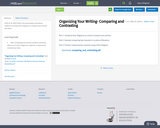
CESA #1 EL OER Project
This presentation introduces students to using a Venn Diagram to compare and contrast two items
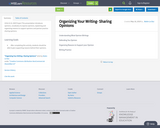
CESA #1 EL OER Project
This presentation introduces opinions, vocabulary to express opinions, explaining and organizing reasons to support opinions and partner practice sharing opinions.

This resource provides a nice example of how osmosis happens through a membrane. It includes definitions, examples, analogies, a chance at writing a hypothesis, an experiment with a log to keep track of results, and graphs to record data.

This website by the Agency for Healthcare Research and Quality clearly explains the common communication barriers in a medical setting, along with techniques to overcome them. Language, hearing, and visual barriers can be overcome by visuals, video aids, written instructions, and medical interpreters. The website provides directions on how to facilitate conversation between the patient, medical professional, and translator. As an interactive activity, students should role-play how they would introduce each communication technique to a patient when there is a communication barrier. By reading and role-playing, students should feel confident communicating with patients through the use of communication aids.
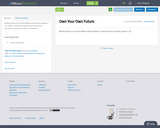
Website where you can find different ACP activities (grades 7-12).
Grades 7-12th grade
A great resource for School Counselors, students, educators, and parents.
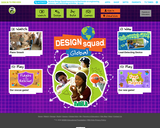
From Site:
NASA and DESIGN SQUAD developed this online workshop for educators and afterschool leaders who want to build their skills and confidence in guiding kids through engineering activities.
Whether you're experienced or new at this, you'll come away with insights and strategies for strengthening your kids' critical-thinking abilities and getting them excited about using the design process, the series of steps engineers use to arrive at solutions.
In this self-guided workshop, you'll:
Experience the design process in action. Learn and reflect on ways you can use the design process to tap into your kids' problem-solving skills and creativity.
Watch an engineering activity. See how easy it is to integrate the design process into the hands-on activities you do with your kids.
Get resources. Discover a variety of engineering activities from NASA and DESIGN SQUAD for kids in grades K–12.

PBS LearningMedia is your destination for direct access to thousands of classroom-ready, curriculum-targeted digital resources. It builds on the strength of public media and is designed to improve teacher effectiveness and student achievement.
Resources are aligned to Common Core and national standards and include videos and interactives, as well as audio, documents, and in-depth lesson plans. You can browse by standards, grade level, subject area, and special collections. You can also favorite and share resources with your class and colleagues. Best of all, PBS LearningMedia is free for PreK-12 educators and students.

Trees, plans, algae, and phytoplankton all do it. Learn about photosynthesis, the process that powers the world.
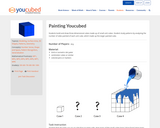
This activity asks students to explore cubes with dimensions 1x1x1 up to 4x4x4. Each cube is painted on all six faces and students are asked to determine how many 1x1x1 cubes have zero painted faces, one painted face, two painted faces and three painted faces. This activiy requires students to consider volume vs. surface area and also offers students the opportunity to predict and make genrealizations using patterns that are noticed.
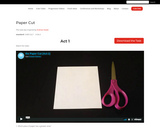
Which piece of paper has a greater area? This 3 Act Task by Graham Fletcher begins with a short portion of a video. A sheet of paper is cut apart leaving the center piece and an outer border piece. First students make observations and estimates to begin determining which piece of paper has a greater area. Students can then use images of the original paper and the middle cut piece of paper along with a measuring tool with square units to determine the area of the pieces. Students are estimating, measuring, multiplying, adding, and subtracting to determine the area of each piece of paper.
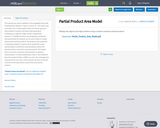
This activity was used in addition to the EngageNY.org Grade 4 Mathematics Module 3, Topic H, Lesson 36 . This lesson was used with a tier 3 fourth grade math intervention group to help students visualize and build understanding of multiplying a 2 digit by 2 digit number using partial products. I modified the lesson by designing a worksheet that would help the students use an area model to visually represent the partial products. My students were proficient in expanded notation, however, they needed the visual representation to build the understanding of where the partial products came from and represented. This helped them move from a pictorial representation to abstract representation. To help solidify place value, it was helpful to have the student shade, in different colors, the rectangle that represents the ones, tens, and hundreds. We also continued to write out the expressions used to find each partial product.
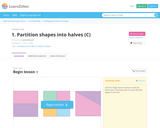
Lesson objective: Understand that shapes can be partitioned into two equal shares that we call halves, and that those two shares together equal one whole.
Students bring prior knowledge of modeling and composing shapes from Grade K, Unit 15, K.G.B.5. This prior knowledge is extended to introduce part-whole relationships of shapes as students partition shapes to demonstrate equal shares that we call halves. A conceptual challenge students may encounter is partitioning shapes unequally because they think that any two parts equal halves.
The concept is developed through work with basic shapes, like rectangles, which support an introduction into thinking about fractional parts of a whole (something students will need to know in future grades).
This work helps students deepen their understanding of equivalence because when a whole is partitioned into halves, the halves must be equal parts of the whole. Additional evidence of equivalence in these key concepts is that 2 halves equal 1 whole.
Students engage in Mathematical Practice 3 (construct viable arguments and critique the reasoning of others) as they help a student partition her rectangular room into equal shares.
Key vocabulary:
equal shares
Special materials needed:
pattern blocksshape cut-outs
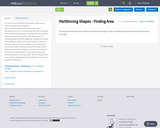
This lesson was used before the Illustrative Math lesson, 3.MD Finding the Area of Polygons, https://www.illustrativemathematics.org/content-standards/tasks/1515. This lesson was used with a 4th grade tier 2 math intervention group to demonstrate that different shapes can have the same area.
Task: Fold and cut six notecards along one of their diagonals. Arrange the triangles into six different shapes. Each shape must be composed of two parts. Only sides of same lengths can be matched up and must be matched exactly. Decide which shape has the greatest area and which shape has the least area. Students will build an understanding of conservation of area and partitioning shapes with equal areas. After the students were secure in their understanding we completed the lesson from Illustrative Mathematics.